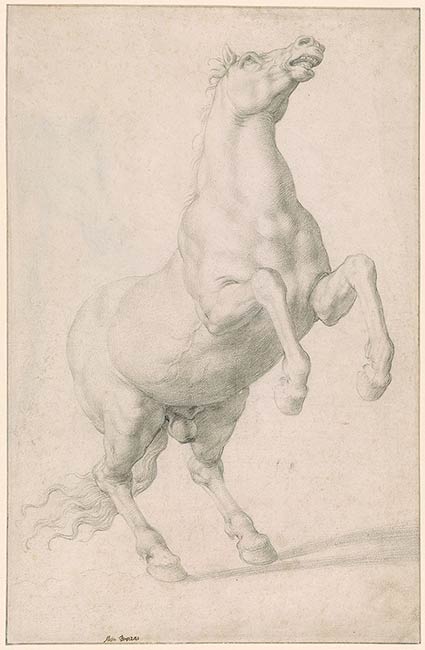

This double-sided drawing came to light in 1984 at a Sotheby’s sale in London, where it was considered the work of the Florentine painter Alessandro Allori. The following year, the sheet entered the Morgan’s collection with this same attribution, and it remained thus catalogued until 2013, when Rick Scorza, having studied the sheet during his time as Thaw Senior Fellow at the Morgan’s Drawing Institute, argued persuasively that the sheet was instead by Allori’s master, Agnolo Bronzino.
Allori began his artistic training with Bronzino at a very young age (presumably when his father died in the early 1540s) and modeled his style on that of his master so closely that discerning between one hand and the other has always been—and is still today—a puzzling problem for drawing experts. Nevertheless, several points provided by Scorza argue convincingly in favor of Bronzino’s authorship of the drawing, primarily its style of execution. The firm, refined chalk strokes, meticulously combined in a dense and precise web of hatched and crosshatched lines, are typical of Bronzino’s graphic vocabulary. These characteristics can similarly be observed in some of the master’s universally accepted works, such as the Joseph with Jacob and His Brothers in the Ashmolean Museum, Oxford,1 which is a fragment of a modello for one of the Medici tapestries that the artist designed for the Sala dei Duecento in the Palazzo Vecchio, Florence, around 1546–48. Scorza related the Morgan drawing to another of the Joseph tapestries produced for the Medici, recognizing it as a preparatory study for the rearing horse at the left edge of the Meeting of Joseph and Jacob in Egypt.2
The verso of the sheet has at its right side the depiction of a horse—possibly drawn from life but more likely created in the artist’s own mind—and at center the freely sketched silhouette of a rearing stallion. This same creature is drawn on the recto, in a rapid but fairly accurate portrayal of one of the two colossal marble horses of the celebrated statuary group known as the Horse Tamers that decorated the Quirinal Hill in Rome. The sketchy quality of the drawing suggests that the figure was outlined in front of the statue during Bronzino’s brief sojourn in the Eternal City in the mid-1540s, a stay that was documented by a letter the artist wrote to the duke of Florence in 1548 in which he mentions his recent return from Rome.3 After delineating the silhouette of the horse on one side of the sheet, Bronzino retraced the same figure on the other side of the paper, finely modeling the volumes and adding compelling details to animate the motion of the animal, such as the fluttering tail and the pulsing vein that runs through the horse’s abdomen.
—MSB
Footnotes:
- Ashmolean Museum, Oxford, inv. wa 1961.ii. See New York 2010a, no. 39
- The horse also appears in reverse in the surviving modello for the tapestry, now in the Marie- Anne Krugier-Poniatowski Collection, Geneva; see Scorza 2013, 9.
- The letter is dated 30 April 1548. See Gaye 1839–40, 2:368–69. See also Scorza 2013, 13n21.
Watermark: none.
Attributed to Bronzino by Rick Scorza in his article in Master Drawings, v. 51, no. 1. Formerly attributed to Alessandro Allori, Florence 1535-1607 Florence, and to Giovanni Battista Naldini Fiesole, ca. 1537-1591, Florence.
Inscribed at lower left in pen and brown ink: "Alesso Bronzino"; on verso at upper right, in red chalk: "S. 324"; at lower left, in black chalk: "107 / Spl."
Allori, Alessandro, 1535-1607, Formerly attributed to.
Naldini, Giovanni Battista, 1537-1591, Formerly attributed to.
Fleischmann, Julius, Mrs., donor.
Thorne, Landon K. Mrs., donor.
Rhoda Eitel-Porter and and John Marciari, Italian Renaissance Drawings at the Morgan Library & Museum, New York, 2019, no. 93.
Selected references: Scorza 2013; Frankfurt 2016, no. 93.
Scorza, Rick. Bellissimi cavagli: A Newly Discovered Bronzino Drawing in the Morgan Library & Museum. Master Drawings, v. 51, no. 1, p. 3-14. ill.
